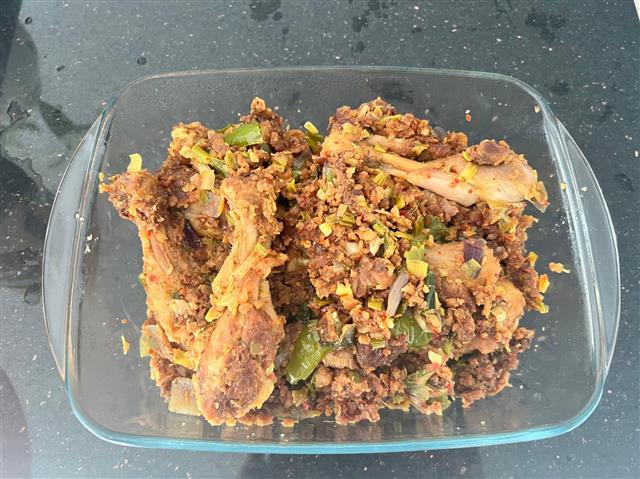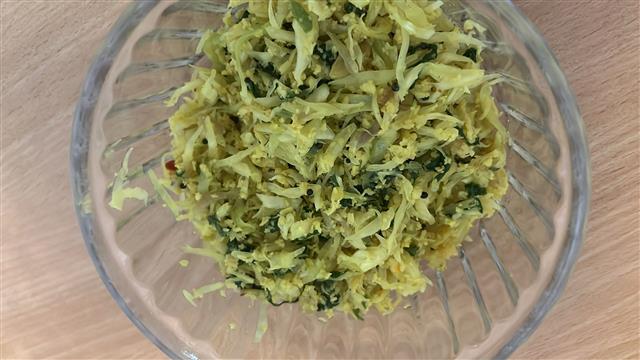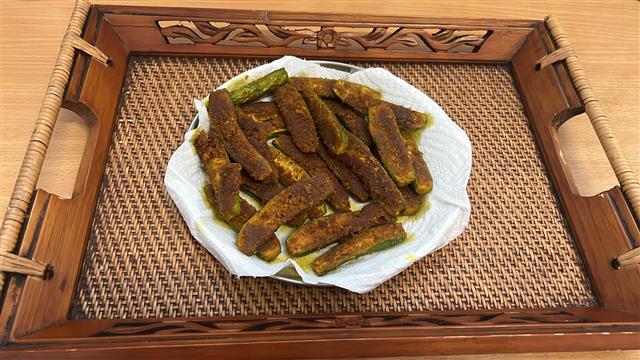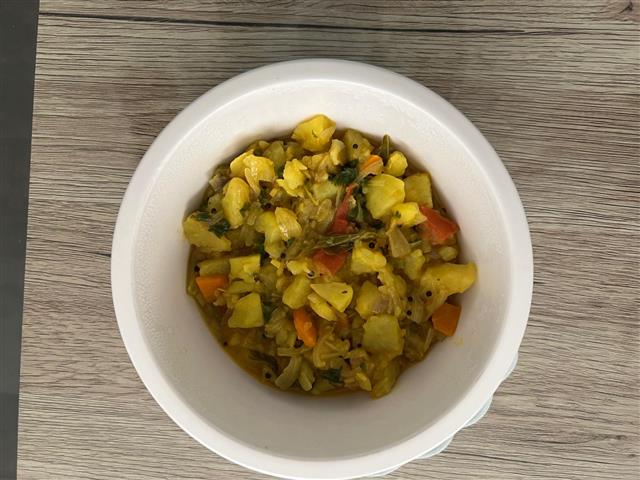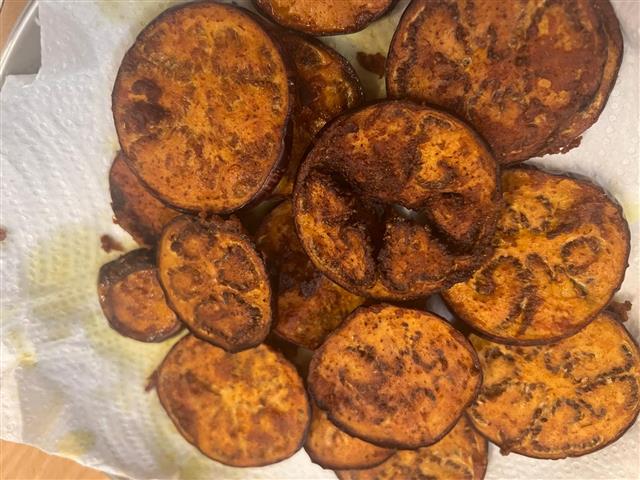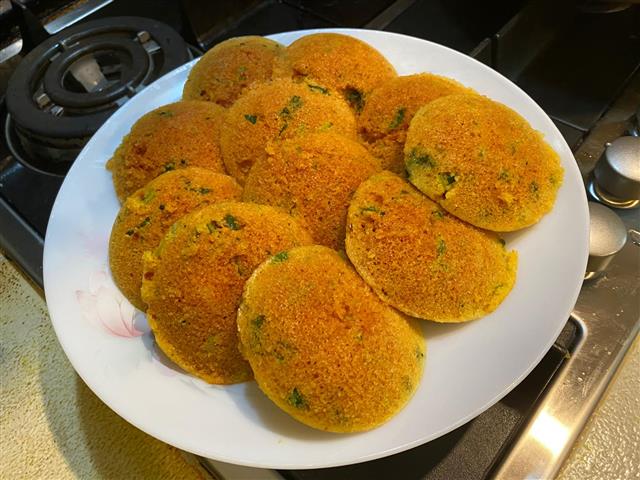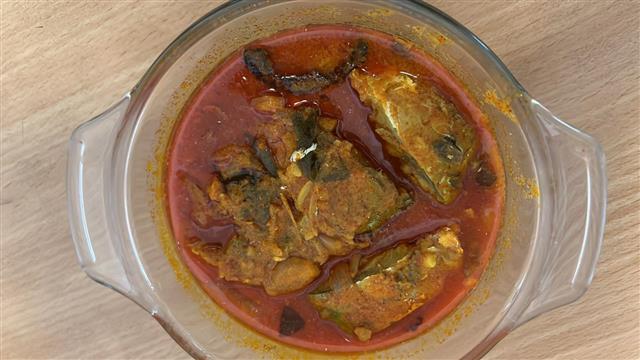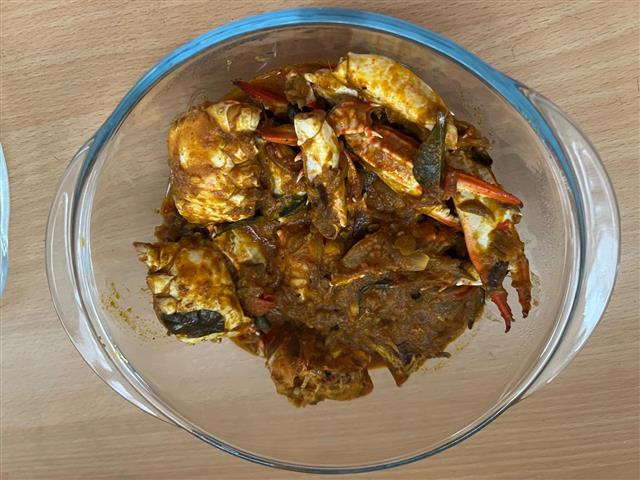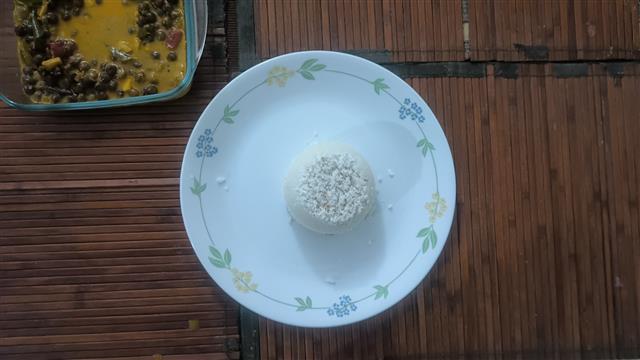
Kerala Fish Curry
(4 reviews)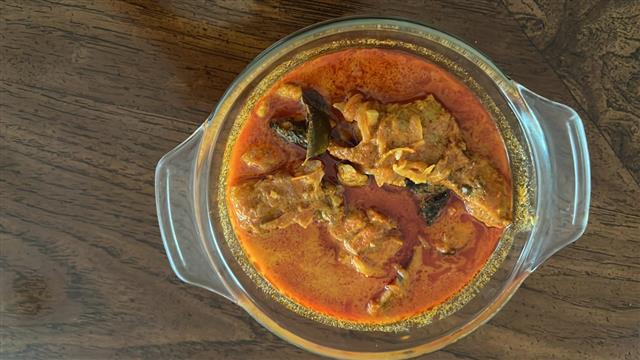
Creamy, tangy, and delicious, this Kerala Fish Curry is a spicy coconut milk-based dish featuring delicate fish, soft shallots, and the distinct smokiness of Gambooge or Malabar tamarind.
This style of curry balances three essential Kerala flavours—sour, spicy, and creamy. Flavoured with a balance of spice and creaminess, it's a classic that brings coastal Kerala right to your plate.
Perfect for those who crave a rich, warming curry with a sour twist and melt-in-your-mouth fish.
Ingredients
Directions
- Heat coconut oil, add uluva (fenugreek seeds) - 1 teaspoon, chummanulli (shallots) - 8, pachamulaku (green chilies) - 2, and curry leaves; sauté until aromatic.
- Mix mulakupodi (chili powder) - 1 teaspoon, Kashmiri chili powder - 1 teaspoon, mannalpodi (turmeric powder) - 1/2 teaspoon, and mallipodi (coriander powder) - 1 teaspoon with water to make a paste.
- Soak kudampuli (Malabar tamarind) in water, add it along with 4 pieces of cleaned and cut fish, a small amount of water, and cook until the fish is done.
- Add 1 cup of water, followed by 1 cup of coconut milk, and simmer until the curry thickens slightly.
- Cook in low heat for 15 minutes
Cooking Tips
• Use earthenware or a clay pot (mann chatti) for an authentic cooking experience. Put the pot on the stovetop and slowly increase the temperature to medium.
• Simmer gently to prevent the fish from breaking. Keep checking the liquid to prevent the fish from burning. Add more liquid, if required.
• Coconut oil is essential. Avoid using other oils, if possible
• The flavour deepens if the curry is rested for a few hours.
How to Serve
• Steamed matta (double-boiled red) rice or white rice
• Kappa (boiled tapioca) for a rustic combo
• Chappathi or Appam to scoop the curry.
• Thoran or Mezhukkupuratti(stir-fried veg) for more people
• Papadam or banana chips for crunch
• Chammanthi(chutney), or even a spicy pickle for contrast
The Story Behind Kerala Fish Curry
This fish curry reminds me of the first time I cooked it in my kitchen. I had no idea if it would taste like the ones I grew up eating, but I was craving something warm and familiar. I remember opening the window to let the curry leaves crackle and the smell of coconut oil fill the space, hoping it would carry me back home.
I followed the recipe, stirring slowly, checking the colour, and tasting the masala. The kudampuli was doing its thing, making everything smell smoky and sour and just right. I added the fish and watched it bubble gently in the spiced gravy that had streaks of oil and soft shallots floating.
It's a dish that requires a bit of patience, but every bite is worth the wait. The coconut milk blends in with the spices, and the fish soaks in all the flavour, flaking apart with the gentlest touch.
Every time I make it now, I remember that moment and realise that this curry does something more than feed me. It nourishes me and keeps me connected to home and the foods I grew up with.
What Is Kerala Fish Curry?
Kerala Fish Curry also known as Meen Curry, is a treasured dish from the southwestern coast of India. Every household and region in Kerala has its version. This particular style of coconut milk and Kudampuli (Malabar tamarind) is loved in the central and southern parts of the state.
A harmonious blend of sour, spicy, and creamy elements. The sourness comes from kudampuli, a smoked and sun-dried tamarind that infuses the curry with its deep, almost citrusy note. The creaminess is from coconut milk, which tempers the heat and brings the dish together. The spice base is built with shallots, green chillies, curry leaves, and just a touch of fenugreek for depth.
This version of meen curry is more than just a meal—it's a link to Kerala's fishing culture, where freshly caught fish is turned into something magical with a handful of pantry staples.
What is Kudampuli?
Also known as garcinia cambogia, gambooge, or fish tamarind, kudampuli is not to be confused with regular tamarind. This dried fruit is native to the Western Ghats and is especially popular in Kerala's seafood preparations. It's usually sliced and sun-dried before being smoked over open flames. This gives it that characteristic blackened appearance and the sharp and slightly citrusy taste
In traditional Kerala kitchens, especially in Syrian Christian households, kudampuli is the preferred souring agent for all kinds of fish and prawn curries.
Why Is Fish Curry Good for You?
Fish is a great source of lean protein, omega-3 fatty acids, and essential nutrients like B12 and selenium. When fish is cooked in coconut milk and gets a tempering of spices, it becomes gut-friendly and anti-inflammatory.
Want to make it healthier?
Choose oily fish like sardines or mackerel as they have high omega-3 content. Serve it with red rice to boost fibre intake and feel fuller for longer.
Malabar Tamarind Swaps
If you can't find kudampuli in the market, I have some swaps that add sourness
→ Lemon Juice and Smoked Paprika Use one tablespoon of lemon juice and a pinch of smoked paprika. It won't replicate the exact tang of kudampuli, but you'll get the acidity with a hint of smoky flavour.
→ Kokum (if available) Kokum is commonly used in Goan and Konkani cuisines. It has a similar tang and dark colour. Soak one or two pieces in warm water and use as you would kudampuli.
→ Green Mango Slices Semi-ripe green mango slices are an excellent natural souring agent. Add four to five thin slices along with the fish and let it simmer gently. Perfect for seasonal cooking.
→ Tomato and Tamarind Paste Use half a tomato and half a teaspoon of tamarind paste for a mild sourness. This combination lacks the smokiness but adds balance.
Note→ Nothing truly replaces kudampuli's smoky, fruity sourness. These swaps work when you run out of fish tamarind.
Pro Tips for Perfect Results
→ Use firm fish like kingfish, pomfret, or sardines. Avoid delicate fillets that break easily.
→ Use thick coconut milk. Don't cook on high heat after adding milk, as it may cause it to split.
→ Don't stir after adding the fish. Let it cook slowly. Just swirl the pot a few times to mix. This prevents the fish from breaking apart.
Kerala Fish Curry Variations
With Freshly Ground Coconut Paste Instead of coconut milk, grind half a cup of grated coconut with a pinch of cumin and a little water to make a thick paste. Add this toward the end of cooking for a nuttier, coarse texture.
With Mango Instead of Kudampuli In summer, semi-ripe green mango slices are swapped for kudampuli in fish curry. This gives the curry a fruity tang and pairs well with firm white fish.
Use Different Fish This recipe works with a variety of fish. Seer fish (neymeen), sardines (mathi), mackerel (ayiaa), or even tilapia. The cooking time may vary depending on the thickness of the fish used.
With Drumsticks or Tomatoes Some home cooks like to add vegetables like drumsticks (muringakka) or extra tomatoes to make a unique taste. Drumsticks add a mild bitterness and soak up the gravy.
Ayala Curry Style For a homestyle sardine curry, follow the same base recipe but add an extra pinch of fenugreek, two cloves of crushed garlic, and a sprig of curry leaves as a final tempering. Check out our detailed Ayala Curry recipe using the search box.
Diet-Friendly Adaptations → Low-Fat Version – Reduce coconut milk to ½ cup and increase tomatoes and chilli powder for a lighter gravy.
→ Vegetarian Version – Use the same masala base with yam or raw plantain instead of fish. It's just as flavorful and perfect for fasting days.
→ Vegan Version – Replace fish with firm tofu or jackfruit for a plant-based take.
Storing & Reheating Tips
→ Fridge: Keeps well for up to 2 days. Flavors deepen overnight!
→ Reheat gently over low heat. Avoid boiling after adding coconut milk.
→ Freezer: Not ideal. The coconut milk may separate.
Common Mistakes to Avoid
→ Sauté the spice paste until the oil separates for maximum flavour.
→ Don't boil the coconut milk. Add it only after the fish is cooked, and simmer gently.
→ Don't overcook the fish or stir too much. They'll break apart and turn mushy.
Frequently Asked Questions
Can I use tamarind paste instead of kudampuli? You can, but the taste will be quite different. Kudampuli gives a smoky depth that regular tamarind can't replicate.
Which fish is best for this recipe? Kingfish, sardines, pomfret, pearl spot (karimeen), or even mackerel work great.
Can I make it in advance? Absolutely! Many people say it tastes best the next day!
Equipment Needed
→ Clay Pot (Mannchatti) – Traditionally used for fish curry. It heats evenly and adds a slight earthiness to the curry. A thick-bottomed steel or nonstick pan works too.
→ Lid – To gently simmer the fish. Tip: If using a clay pot, soak it in water for 15–20 minutes before first use (or after long storage) to prevent cracking.
→ Small Kadai or Frying Pan – For sautéing the aromatics and toasting spices.
→ Wooden Spoon or Spatula – Helps avoid scraping the surface of clay or nonstick pans.
→ Measuring Spoons and Cups
→ Small Bowl – For soaking kudampuli or tamarind.
